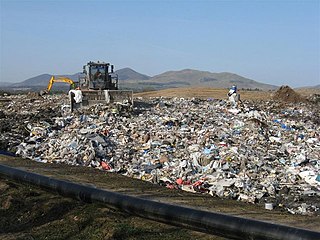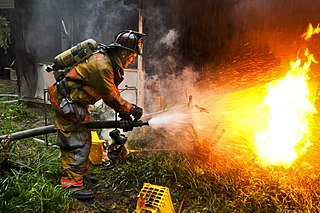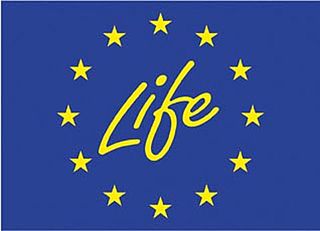
Environmental laws are laws that protect the environment. Environmental law is the collection of laws, regulations, agreements and common law that governs how humans interact with their environment. This includes environmental regulations; laws governing management of natural resources, such as forests, minerals, or fisheries; and related topics such as environmental impact assessments.Environmental law is seen as the body of laws concerned with the protection of living things from the harm that human activity may immediately or eventually cause to them or their species, either directly or to the media and the habits on which they depend.

Waste hierarchy is a tool used in the evaluation of processes that protect the environment alongside resource and energy consumption from most favourable to least favourable actions. The hierarchy establishes preferred program priorities based on sustainability. To be sustainable, waste management cannot be solved only with technical end-of-pipe solutions and an integrated approach is necessary.

In environmental law, the polluter pays principle is enacted to make the party responsible for producing pollution responsible for paying for the damage done to the natural environment. This principle has also been used to put the costs of pollution prevention on the polluter. It is regarded as a regional custom because of the strong support it has received in most Organisation for Economic Co-operation and Development (OECD) and European Union countries, and has a strong scientific basis in economics. It is a fundamental principle in US environmental law.

Electronic waste describes discarded electrical or electronic devices. It is also commonly known as waste electrical and electronic equipment (WEEE) or end-of-life (EOL) electronics. Used electronics which are destined for refurbishment, reuse, resale, salvage recycling through material recovery, or disposal are also considered e-waste. Informal processing of e-waste in developing countries can lead to adverse human health effects and environmental pollution. The growing consumption of electronic goods due to the Digital Revolution and innovations in science and technology, such as bitcoin, has led to a global e-waste problem and hazard. The rapid exponential increase of e-waste is due to frequent new model releases and unnecessary purchases of electrical and electronic equipment (EEE), short innovation cycles and low recycling rates, and a drop in the average life span of computers.

Soil contamination, soil pollution, or land pollution as a part of land degradation is caused by the presence of xenobiotic (human-made) chemicals or other alteration in the natural soil environment. It is typically caused by industrial activity, agricultural chemicals or improper disposal of waste. The most common chemicals involved are petroleum hydrocarbons, polynuclear aromatic hydrocarbons, solvents, pesticides, lead, and other heavy metals. Contamination is correlated with the degree of industrialization and intensity of chemical substance. The concern over soil contamination stems primarily from health risks, from direct contact with the contaminated soil, vapour from the contaminants, or from secondary contamination of water supplies within and underlying the soil. Mapping of contaminated soil sites and the resulting clean ups are time-consuming and expensive tasks, and require expertise in geology, hydrology, chemistry, computer modelling, and GIS in Environmental Contamination, as well as an appreciation of the history of industrial chemistry.

Environmental crime is an illegal act which directly harms the environment. These illegal activities involve the environment, wildlife, biodiversity and natural resources. International bodies such as, G7, Interpol, European Union, United Nations Environment Programme, United Nations Interregional Crime and Justice Research Institute, have recognised the following environmental crimes:

Landfills in the United Kingdom were historically the most commonly used option for waste disposal. Up until the 1980s, policies of successive governments had endorsed the "dilute and disperse" approach. Britain has since adopted the appropriate European legislation and landfill sites are generally operated as full containment facilities. However, many dilute and disperse sites remain throughout Britain.

The Landfill Directive, more formally Council Directive 1999/31/EC of 26 April 1999, is a European Union directive which regulates waste management of landfills in the European Union. It was to be implemented by EU Member States by 16 July 2001. Directive (EU) 2018/850 amended the 1999 directive with effect from 5 July 2020.

The Jiyeh Power Station oil spill is an environmental disaster caused by the release of heavy fuel oil into the eastern Mediterranean after storage tanks at the thermal power station in Jiyeh, Lebanon, 30 km (19 mi) south of Beirut, were bombed by the Israeli Air force on July 14 and July 15, 2006 during the 2006 Israel-Lebanon conflict. The plant's damaged tanks leaked up to 30,000 tonnes of oil into the eastern Mediterranean Sea, A 10 km wide oil slick covered 170 km of coastline, and threatened Turkey and Cyprus. The slick killed fish, threatened the habitat of endangered green sea turtles, and potentially increased the risk of cancer.

Dibutyl phthalate (DBP) is an organic compound which is commonly used as a plasticizer because of its low toxicity and wide liquid range. With the chemical formula C6H4(CO2C4H9)2, it is a colorless oil, although commercial samples are often yellow.

The Convention for the Protection of the Marine Environment of the North-East Atlantic or OSPAR Convention is the current legislative instrument regulating international cooperation on environmental protection in the North-East Atlantic. Work carried out under the convention is managed by the OSPAR Commission, which is made up of representatives of the Governments of the 15 signatory nations, and representatives of the European Commission, representing the European Union.
The Erika legislative packages of the European Union are maritime laws intended to improve safety in the shipping industry and thereby reduce environmental damage to the oceans.

Firewater refers to water that has been used in firefighting and requires disposal. In many cases, it is a highly polluting material and requires special care in its disposal.

Waste management laws govern the transport, treatment, storage, and disposal of all manner of waste, including municipal solid waste, hazardous waste, and nuclear waste, among many other types. Waste laws are generally designed to minimize or eliminate the uncontrolled dispersal of waste materials into the environment in a manner that may cause ecological or biological harm, and include laws designed to reduce the generation of waste and promote or mandate waste recycling. Regulatory efforts include identifying and categorizing waste types and mandating transport, treatment, storage, and disposal practices.

The LIFE programme is the European Union's funding instrument for the environment and climate action. The general objective of LIFE is to contribute to the implementation, updating and development of EU environmental and climate policy and legislation by co-financing projects with European added value. LIFE began in 1992 and to date there have been five phases of the programme. During this period, LIFE has co-financed some 4600 projects across the EU, with a total contribution of approximately 6.5 billion Euros to the protection of the environment and of climate. For the next phase of the programme (2021–2027) the European Commission proposed to raise the budget to 5.45 billion Euro.
Environmental protection expenditure accounts (EPEA) are a statistical framework that describes environmental activities in monetary terms and organises these statistics into a full set of accounts, just like that of the national accounts. The EPEA is part of the System of Integrated Environmental and Economic Accounting which, in March 2012, was adopted as a statistical standard by the United Nations Statistical Commission.
Environ was a privately held, international environmental, safety and health sciences consulting firm headquartered in Arlington, Virginia. ENVIRON had operations across more than 90 offices in 21 countries, with more than 1,500 consultants when it was acquired in December 2014 by Danish-based Ramboll.

Environmental cleanup laws govern the removal of pollution or contaminants from environmental media such as soil, sediment, surface water, or ground water. Unlike pollution control laws, cleanup laws are designed to respond after-the-fact to environmental contamination, and consequently must often define not only the necessary response actions, but also the parties who may be responsible for undertaking such actions. Regulatory requirements may include rules for emergency response, liability allocation, site assessment, remedial investigation, feasibility studies, remedial action, post-remedial monitoring, and site reuse.
Turkey generates about 30 million tons of solid municipal waste per year; the annual amount of waste generated per capita amounts to about 400 kilograms. According to Waste Atlas, Turkey's waste collection coverage rate is 77%, whereas its unsound waste disposal rate is 69%. While the country has a strong legal framework in terms of laying down common provisions for waste management, the implementation process has been considered slow since the beginning of 1990s.










